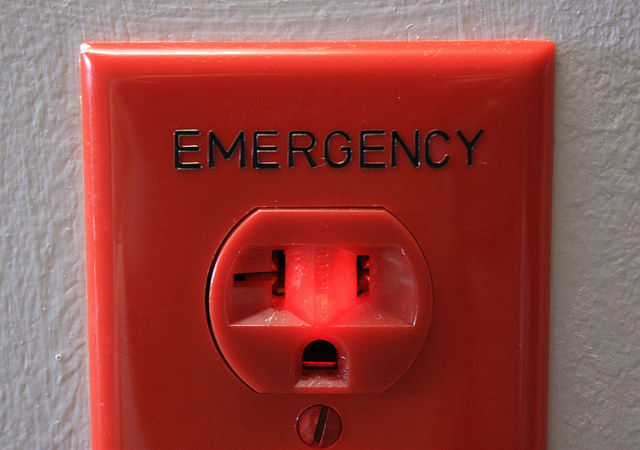Australian emergency services in need of a lift
Posted By Anthony Bergin on January 23, 2013 @ 12:58
 [1]
[1]As we’re reminded every bushfire season, Australians are more vulnerable during emergencies that can arise with little warning. We do a fair job of dealing with them, and thankfully we’ve been very lucky to avoid facing a catastrophic event that would produce extensive casualties: a significant terrorist attack, a large-scale industrial accident, a collapse of a city skyscraper, an air disaster, or a tsunami hitting a big population centre. Even an ongoing heat wave that occurred across the country would challenge our healthcare services [2]. The truth is that we’re unprepared to respond to a major disaster.
Those judgments are based on the findings of the December report by the National Health Performance Authority on our emergency departments [3]. As I’ve argued in the context of our preparedness for a mass casualty terrorist attack [4], surge capacity—the ability of the medical system to care for a massive influx of patients—remains one of the most serious challenges for national emergency preparedness.
The NHPA report shows that no major metropolitan hospital in NSW, Victoria, Western Australia, Tasmania or Queensland had met state emergency department benchmarks in the first six months of last year. The Australasian College for Emergency Medicine noted that, across the nation, the sick patients—those who needed to be admitted—are more likely to have inappropriately long stays in emergency [5] (Word doc). Research overseas [6] (PDF) has found that patients admitted to hospitals via crowded emergency departments might be more likely to die in the hospital than similar patients admitted during slow periods.
Hurricane Sandy in the US recently underscored the importance of emergency care in the face of disaster [7], when major hospitals in New York lost power and had to evacuate patients at short notice and in dramatic circumstances.
In developing our health response to a disaster we face some fundamental constraints:
- most ambulance and hospital services are overstretched on a daily basis. Pre-hospital and paramedic capacity, along with medical and nursing shortages, limits surge capacity for a large influx of critically injured patients
- few of our hospital staff and paramedics have been involved in no-notice, large scale disaster exercises, using the equipment they’re supposed to be competent on
- finding adequate numbers of ambulances will be a problem for most states in the event of a disaster. There are no formal protocols between the states for the deployment of paramedics and ambulances
Clearly we have a problem. The first step in working out a response is to identify the shortfalls and set some performance goals. If the new National Health Performance Authority [8] was to audit our national healthcare preparedness for large-scale disasters on a regular basis, then our healthcare system would then know what they were reasonably expected to be able to cope with and could plan appropriately, including what funding is required.
Speed is life in critical cases, and again we lack the ability to move lots of patients quickly—or to move response teams to the victims. As I and the former Director-General of EMA have argued recently, an immediate priority should be to address inadequacies in national casualty airlift [9] (PDF). The right capability might look like several planes each of which that can carry at least six to 10 stretchers in an appropriate airframe to handle patients needing ICU treatment, with certified equipment and ready to go immediately.
With minimal investment and a contractual agreement with Qantas and Virgin, we could configure up to four aircraft with the requisite kit, when required, for medivac use as part of the commercial fleet on the east and west coasts. Similar arrangements are already in place in the United States [10]. Suitable military transport aircraft might be available, but the RAAF must balance this role with military operations, training and maintenance. In any event, Defence assets rely on doctors and nurses who often have to balance their civilian life with their part-time military service as specialist reservists.
There’s a lot we could do to prevent the adverse health consequences that will flow from disasters. It’d be much better to deal with this proactively rather than after a ‘lessons learned’ report.
Anthony Bergin is deputy director of the Australian Strategic Policy Institute. Image courtesy of Flickr user kayaker1204 [11].
Article printed from The Strategist: https://www.aspistrategist.org.au
URL to article: https://www.aspistrategist.org.au/australian-emergency-services-in-need-of-a-lift/
URLs in this post:
[1] Image: http://www.aspistrategist.org.au/wp-content/uploads/2013/01/5985621727_632c80840a_z.jpeg
[2] challenge our healthcare services: http://www.abc.net.au/news/2010-12-09/expert-urges-better-planning-for-heatwaves/2369860
[3] National Health Performance Authority on our emergency departments: http://www.nhpa.gov.au/internet/nhpa/publishing.nsf/Content/Media-Release-First-report-shows-large-variation-in-hospital-performance
[4] preparedness for a mass casualty terrorist attack: http://www.aspi.org.au/publications/publication_details.aspx?ContentID=121
[5] are more likely to have inappropriately long stays in emergency: http://www.acem.org.au/home.aspx?docId=1
[6] Research overseas: http://www.annemergmed.com/webfiles/images/journals/ymem/FA-bcsun.pdf
[7] importance of emergency care in the face of disaster: http://www.nejm.org/doi/full/10.1056/NEJMp1213486
[8] National Health Performance Authority: http://www.nhpa.gov.au/internet/nhpa/publishing.nsf
[9] address inadequacies in national casualty airlift: http://www.aspi.org.au/pdf/How_to_cope_with_a_major_emergency.pdf
[10] already in place in the United States: http://usmilitary.about.com/library/milinfo/affacts/blcivilreserveairfleet.htm
[11] kayaker1204: http://www.flickr.com/photos/kayaker1204/5985621727/
Click here to print.